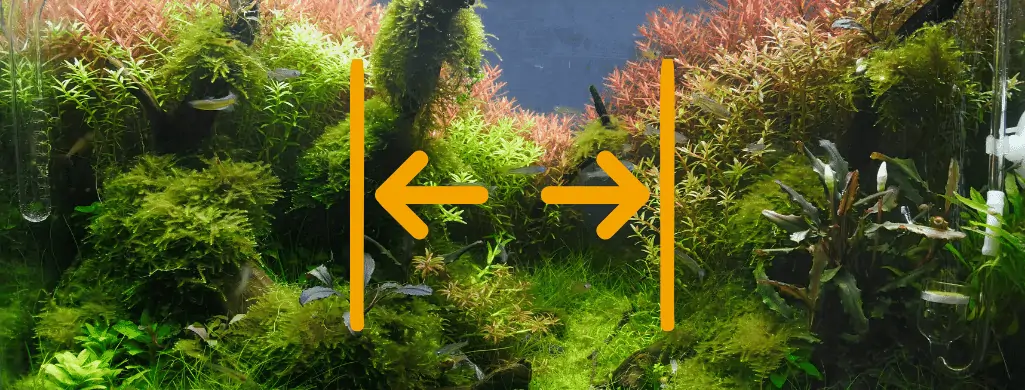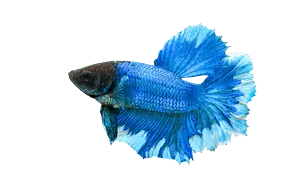Before dividing your aquarium, you need to consider the size of your tank, the demeanor of all your fish, and what kind of divider works best for your set-up.
Because betta fish behave uniquely, these factors are even more important when installing a betta fish tank divider.
Divided tanks are often the right choice for your betta fish, especially when you want to keep more than one male betta. Use something opaque so your betta fish cannot see one another. Give each of your fish plenty of water, at least 5 gallons of space each.

Table of Contents
Why Divide Your Betta Tank?
There are many reasons you might want to divide your betta aquarium:
- Keeping more fish
- Bullying
- Larger tank size
- Injured fish
More Fish
When you have a betta fish, you start to get limited on who else can go in your fish tank.
Making divisions for new fish means raising different types of fish species and adding some variety to your space.
This is especially important if you need to buy a second betta fish.
While female betta sororities are another option for this, they are also incredibly hard to successfully set up and maintain.
Keeping two males (or two females, or a male and a female) in their own 5-gallon sections is much easier.
This makes raising multiple bettas a little more beginner-friendly as well.
Sometimes different fish species prefer different environments.
For example, one species likes sand as a substrate, while another needs fine gravel.
Or you have a betta who loves a heavily planted aquarium with a weak swimmer who needs more space between decorations.
Bullying
While betta fish do very well in community tanks, they sometimes get too rough.
If your betta is bullying another fish or being bullied by them, dividing the tank is a relatively quick fix.
Separating aggressive fish means you need to use an opaque divider!
When the two fish can still see each other, they will continue to feel stressed out by one another’s presence.
By getting the other fish out of sight and out of mind, you do a much better job calming your pets down.
If you need an opaque divider, here’s the popular Lifewithpets divider on Amazon for a pretty low price.
The only downfall is some say it leaves a tiny gap on the side.
When dividing the aquarium to keep smaller fish like tetras away from your betta, you may want to look at something different.
Make sure any divider you buy is designed for your tank type. Also, check whether it’s right for your betta’s tank size.
Larger Tank Size
Buying one larger tank rather than multiple smaller ones is often the less expensive option.
This is especially true for experienced aquarists and people who enjoy raising many fish simultaneously.
Larger tanks also help keep water quality up.
Poor water quality often results when fish is kept in too small of a tank because ammonia builds up much more quickly.
Some fish don’t do well in a community tank.
Depending on the personality of your betta fish, they may very well be the one who needs to be separated.
Inserting a divider is a great way to keep the aesthetic of a big community tank without endangering your pets.
Here’s a divider we like for bigger fish tanks. It works well for betta fish and does not leave room for them to sneak through.
It isn’t fully dark, so each fish can see the other one(s) moving on the opposite side of the tank.
But because they don’t fully see one another, there is no perceived threat. So this won’t be a problem.
This divider also uses suction cups to stay in place.
I know some people prefer not to use suction cups in their tanks.
But the bigger your aquarium is, the harder it is to find dividers without suction cups.
Injured Fish
Sometimes you need to divide your tank super fast in a pinch.
We recommend always having a tank set up for sick or injured fish.
Of course, we never plan for our pets to get hurt or sick. But being prepared for when it happens will help you out a ton.
When you find yourself in a pickle without a fishy sick bay, dividing the tank is a much more efficient solution than setting up a whole new tank.
It’s also a lot cheaper!
Remember, tank dividers are not designed to stop illness from spreading. Both sides of the tank share the same air and water flow.
Dividing is a much better option for separating a fish that has been hurt in some way or is extremely stressed.
You also need to ensure all your fish still have plenty of space.
Each betta needs at least 5 gallons of water available to swim in.
Stress is only made worse by cramped spaces.
Installing a Commercial Tank Divider
Most tank dividers are extremely easy to place in the tank.
Find one without suction cups; you just have to slide it in wherever you want it. It will stay in place if it fits correctly without extra work.
Lifewithpets has a short tutorial if you want a visual aid while you adjust your divider:

This tutorial focuses specifically on dividers without suction cups.
Fortunately, even with suction cups, dividers are quick and easy to install. Put the cups onto the divider first, then put your divider into the tank.
Remember always to install a divider in a dry tank.
DIY Tank Dividers
Why Go DIY?
Simply put, fish tanks come in weird shapes.
Most tank dividers sold commercially are only offered in a few sizes and stick to standard dimensions.
Even the adjustable ones are made with a certain aquarium shape in mind.
Considering the price of most tank dividers, you might prefer to make your own instead.
This way, you also get to customize the divider for your fish.
The bigger your tank, the fewer options you have when you buy a divider.
It becomes more difficult to find an opaque one or one with small enough holes for certain fish species.
When you craft your own mesh divider, the possibilities are virtually endless.
What You Need
The first step to making your craft mesh divider is to gather all the necessary materials.
Flat plastic mesh sheets are widely available and come in many different sizes.
Amazon has a huge selection of them in both black and white, some of which are intended to be used as tank dividers.
Getting a multi-pack of plastic mesh sheets means you even get to divide your larger tank into more sections if you want to.
The sheets linked above include plastic sliders. But if you buy them without sliders, you must find some separately.
Instead of looking at the craft store for these, find an office supply store. They are much more likely to have what you need.
Look for the words ‘binders’ or ‘slide and bind,’ which is often how these are marketed.
You’re going to need a pair of scissors as well and a little pack of suction cups.
Suction cups tend to come at a very low price.
But you will probably have to pull little hooks off the backs of them before they’re ready to use.
Adjusting the Mesh Sheet
Got everything? Awesome.
The toughest part of creating your own divider is getting the right size.
The divider must fit snugly in the aquarium without putting too much pressure on the glass or bending it into a weird shape.
The trick here is to place it vertically against the outside of the fish tank you will be using.
First, cut it down, so it fits exactly to the sides of the tank. Slide it inside and see how everything looks.
It is going to be a little big!
Get an idea of how much more you need to trim. But always err toward making it bigger than you think it needs to be.
Nobody has the power to un-cut those mesh sheets. But trimming them smaller is always an option.
Once the sides are about right, it’s time to get your divider to the correct height.
Betta fish can jump above the surface of the water, which in a betta tank must always be a few inches below the lid.
If your betta’s divider is not high enough to fit snugly with the lid on, your fish may jump right over it to the other side.
Or, worse yet, they could get stuck halfway.
Your mesh divider must be taller than the proper water level but still fit with the tank’s lid in place.
Assembling the Divider
Once your mesh sheet fits snugly in the tank, it’s time to add the sliding binders.
They should slip on very easily.
Once you have the binders on each side of the sheet, slip it back into the tank.
You may have to trim the sheet a little more as the binders add a bit of length.
Make sure the divider fits snugly with the binders attached.
When you finally know the sheet is the correct size, this is the time to cut a second sheet if you want one.
Why would you need a second sheet?
Even using dark-colored plastic mesh, the nature of mesh is partly see-through.
Betta fish need an opaque divider most of the time, so it is better to be safe than sorry.
We recommend using a double-layer divider for your betta fish tank.
After all, one of the perks of prepping your own divider is how much easier it is to customize it like this!
Once both sheets are cut to size, slide them into the binders.
The best practice is to use binders on the top and bottom of the sheet as well. This prevents your fish from coming into contact with hard plastic and potentially sharp edges.
As you know, jagged edges are a recipe for disaster in a betta tank.
Trim the binders as needed to ensure everything fits in the tank nicely.
Installing the Divider
You might notice how snugly it fits when you put the divider in your aquarium.
Even when you move the aquarium, the divider should stay in place without the extra support of the suction cups.
However, you will definitely want to use the suction cups for extra security.
Put the divider in the tank, and then grab your suction cups.
You are going to put a substrate in your betta tank, so you don’t need to secure the bottom of the divider with these cups.
The layer of sand or gravel will be just as good at holding everything in place.
Instead, place two at the top of each side of your divider.
Make sure the suction cups are as close to the divider as possible.
With all this in place, congratulations!
You’re ready to throw in some aquatic plants, prepare clean water, and invite your betta fish to their new home!
Visual Aid
Sometimes, reading isn’t enough to learn a new skill.
So if you are a visual learner, here’s a video by Solid Gold Aquatics to help you create and install your DIY tank divider:

Aquarium Sweet Aquarium
There are a million reasons to divide your betta tank, but be sure to get a well-fitted and opaque divider.
This is a good one for smaller tanks, and this is a good one for larger tanks.
If you choose to make your own divider, check out our guide above and get some plastic mesh sheets on Amazon!
Send this article to anyone you know who is considering a divided tank so they know what they need.


